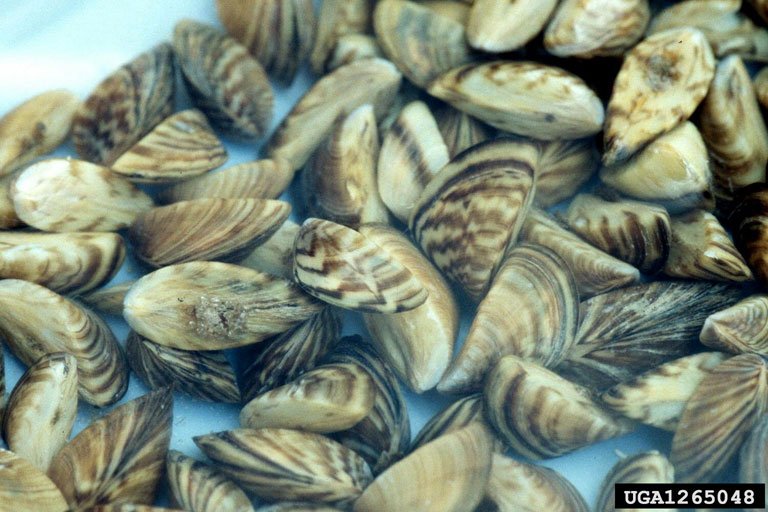
Zebra Mussels
Help Prevent Their Spread
Clean
CLEAN any mussels and plant material from your boat, trailer, and equipment after each use and with hot water (45°C) when possible.
Drain
DRAIN water from all internal compartments, ballast tanks, live wells, bilges, bait buckets, and motors on land and at least 30m away from the water.
Dry
DRY any remaining standing water using a sponge or towel.
Inspect
INSPECT boats or other equipment (eg. trailers, boat lifts) bought from other areas before placing them in the water.
What are Zebra Mussels?
Zebra Mussels are invasive freshwater mussels that have been recently found in the Madawaska River, located in northern New Brunswick. They attach themselves to any solid surface (ex: boats, docks, rocks, etc.) in groups up to 700,000 individuals/m2, where they filter the water in large quantities.
They negatively impact freshwater ecosystems by:
Over-filtering the water, which leads to:
The depletion of food sources like plankton, which are needed by other species
Clear water that allows sunlight to penetrate deeper, which can increase the growth of invasive aquatic plants like Eurasian Watermilfoil.
Increasing toxic algae blooms, pathogenic bacteria, avian botulism, which impacts fish and wildlife.
Altering spawning areas by changing the materials on the bottom on the waterways, which impacts fish egg survival
Their presence also impacts recreational activities and vital infrastructure since they can cover various hard surfaces, and their razor-sharp shells put beach-goers at a risk of cutting their feet.
2025 Zebra Mussel Update
In 2025, aquatic invasive species work kept us busy! We did lots of Zebra Mussel monitoring all around the province.
We installed and later removed 20 collector plates along the Wolastoq, ranging from Perth-Andover down to the Saint John Marina.
We collected 30 water quality samples with help from our partners at the KWRC and JSGWA.
We collected veliger samples with our partners DNRED, UNB Biology, and Canadian Rivers Institute!
We sampled for environmental DNA (eDNA) at 26 locations in the province, some being in the main stem of the Wolastoq, its main tributaries, and many freshwater lakes.
Complementing this, we operated our mobile decontamination unit at 20 angling tournaments and other recreation events, ensuring boats were cleaned to help prevent aquatic invasive species from hitching a ride between waterbodies.
To end our season, we performed visual dock inspections at Woodstock, Nackawic, Mactaquac, Fredericton, and Gagetown.
We are happy to report that no Zebra Mussel were found on the collector plates or the inspected docks, and all eDNA sampling outside of the main stem of the Wolastoq (Saint John River) were negative! We are still waiting on the veliger sampling results. This is great news, as it means the spread of Zebra Mussel has not significantly advanced since last year's monitoring efforts.
How to Identify Zebra Mussels
Size: very small; average size of 2-2.5 cm, reaching up to 4 cm long.
Shell: triangular shape with a flat underside and noticeable zig-zag pattern of black to brown with white and yellow.
Attachment: attaches to solid surfaces using hairlike byssal threads that extend from underneath their shells.
Report Zebra Mussels Now!
1.Take photos
close up
2. Note the following:
the exact location (GPS coordinates)
the observation date
identifying features
photos/videos available
3. Report your observation:
New Brunswick Invasive Species Council
Phone: 506-262-6247
Email: report@nbinvasives.ca
OR
Fisheries and Oceans Canada
Toll-free: 1-866-759-6600
Email: Invaders.glf@dfo-mpo.gc.ca
On-The-Ground Projects
Since the discovery of Zebra Mussels in in Lake Témiscouata, Québec, Fisheries and Oceans Canada (DFO) and its provincial, municipal, non-governmental and Indigenous partners have been closely monitoring New Brunswick’s lakes and rivers for any new presence of this aquatic invasive species (AIS).
In 2023, collective monitoring efforts in these areas led to the sighting of live Zebra Mussels along a hydroelectric dam in Edmundston. The dam is located on New Brunswick’s Madawaska River, about 40 kilometres downstream from Lake Temiscouata. DFO confirmed that the specimens collected at the dam by the Société d'aménagement de la rivière Madawaska (SARM) in late August, 2023, are Zebra Mussels. This marked the first confirmed observation of this aquatic invasive species in N.B. waters.
Thanks to the Aquatic Invasive Species Prevention Fund, a new contribution fund launched earlier this year, DFO is supporting the Organisme de bassin versant du fleuve Saint-Jean (OBVFSJ) and its partners in the implementation of an Action Plan to limit the spread of Zebra Mussels throughout the Saint John River watershed.
The Action Plan, which is a collaborative effort between stakeholders in Quebec and New Brunswick, will map areas that are most vulnerable to the presence of Zebra Mussels and ensure that a network of boat washing stations is set up in key locations. These stations will teach boaters how to stop the spread of Zebra Mussels by cleaning, draining and drying their watercraft. In addition, a public education and awareness campaign on best practices to control the spread of this aquatic invasive species will be launched.
Organisme de bassin versant de fleuve Saint-Jean
Project Partners
New Brunswick Invasive Species Council
Société d'aménagement de la rivière Madawaska
Northwest Regional Service Commission
Comité de l’aménagement rural du Nord-Ouest














